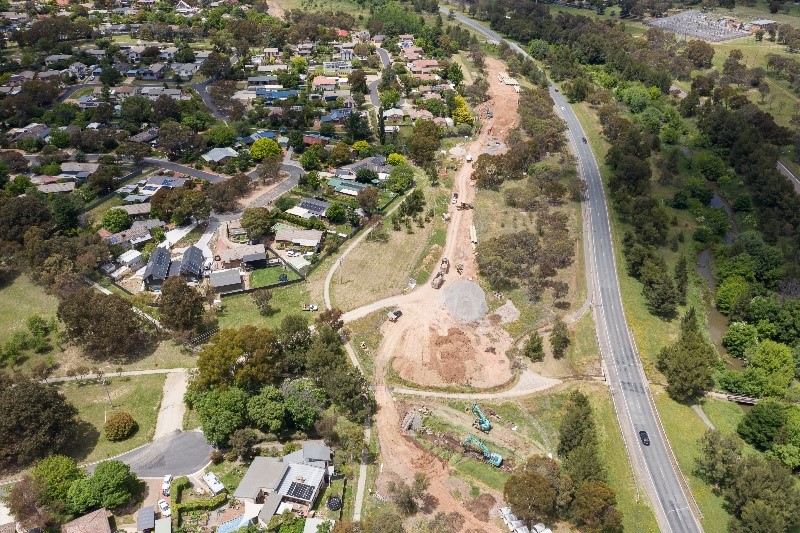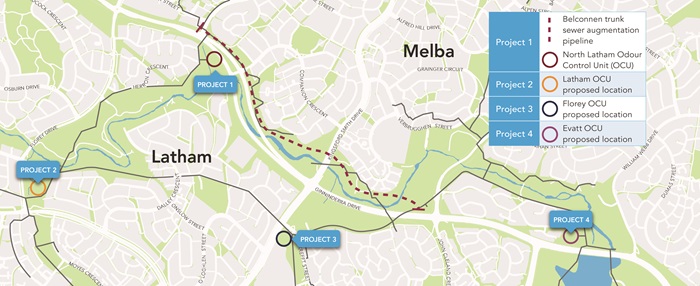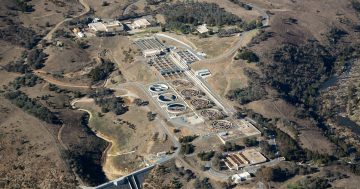
Drone footage from the Belconnen sewerage area. Photo: Icon Water.
The Ginninderra Catchment Group has leapt to the defence of Icon Water after a group of Belconnen residents called for a construction halt on a major sewerage project.
The project involves building a new trunk sewer in the Belconnen area, extending from Copland Drive to Tillyard Drive. The sewer network being upgraded was built in the 1960s to service Gungahlin, Hall and Belconnen. The network is now nearing capacity, and with further growth expected soon, Icon Water believes sewerage upgrades are essential and increasingly urgent.
The Belconnen residents, the Umbagong Protection Group, is concerned about impacts on the environment, health and the area’s visual appeal. They are mainly concerned with the above-ground odour control unit (OCU), which will sit at the Umbagong District Park.
Catchment coordinator at the Ginninderra Catchment Group Kathryn McGilp disputed this, arguing that Icon Water has gone “above and beyond their environmental duty”.
“The Ginninderra Catchment Group and our local Umbagong Landcare group has engaged with Icon Water quite extensively throughout the planning process, and they’ve actually made quite significant changes to protect critically endangered grassland that’s actually found throughout Umbagong,” said Ms McGilp.
“They’ve adopted and changed their footprint quite significantly to protect those heritage spots.”
“We’re actually quite happy with their process overall, and they’ve also made a commitment to revegetate a significant portion of the pipeline with critically endangered grasslands species as well,” she said.
Along with four OCUs, the project will include approximately 2.4 km of sewer pipe and 18 sewer utility holes. Part of the piping will include the installation of a 170-metre long pipe bridge crossing Ginninderra Creek.

The sewerage project map outline. Photo: Icon Water.
General manager of Infrastructure Services at Icon Water Gerard Brierley says the upgrades are essential to service the growing population and protect the local waterways.
“The increased capacity will ensure we can safely process the full volume of wastewater from the area, avoiding potential environmental impacts caused by wastewater leaks. Long-term asset protection ensures we are investing responsibly for the growing community and extending the asset life as well,” said Mr Brierley.
“In addition to improving capacity, the network also requires extra ventilation and filtration systems (odour control units) to be installed to protect the existing sewerage infrastructure and ensure efficient and safe operation of the network and for our staff. This is why we are building four strategically positioned odour control units in the area.”
Addressing concerns raised about the potential health impact, Mr Brierley said the OCUs extract gas from specially engineered ducting. When discharged, it will be at a very low concentration, minimising the impact on the community. He added that the necessary measures to constantly monitor this impact would be in place.
Concerning the OCU at Umbagong District Park, Mr Brierly said they refined the location after consulting with environmental groups to minimise the impact on both visual appeal and the native grasslands.
“The proposed location was moved so that it is adjacent to existing stormwater infrastructure to minimise the impact on the existing blue devil natural temperate grassland and to be closer to Florey Drive so that maintenance vehicles do not need to traverse too far inside the park,” he said.
“We have been working closely with the community to obtain feedback on how the OCUs may be finished to minimise visual impact. To date, community support for mural artwork has been expressed. We are still seeking feedback from the community on their preference for finishing the OCUs.”
Upon completion of project works, the sites will be restored using dryland, native grasses and tree plantings, which Mr Brierly believes could enhance the ecological value from before the project.















